- © 2025 Annapolis Home Magazine
- All Rights Reserved
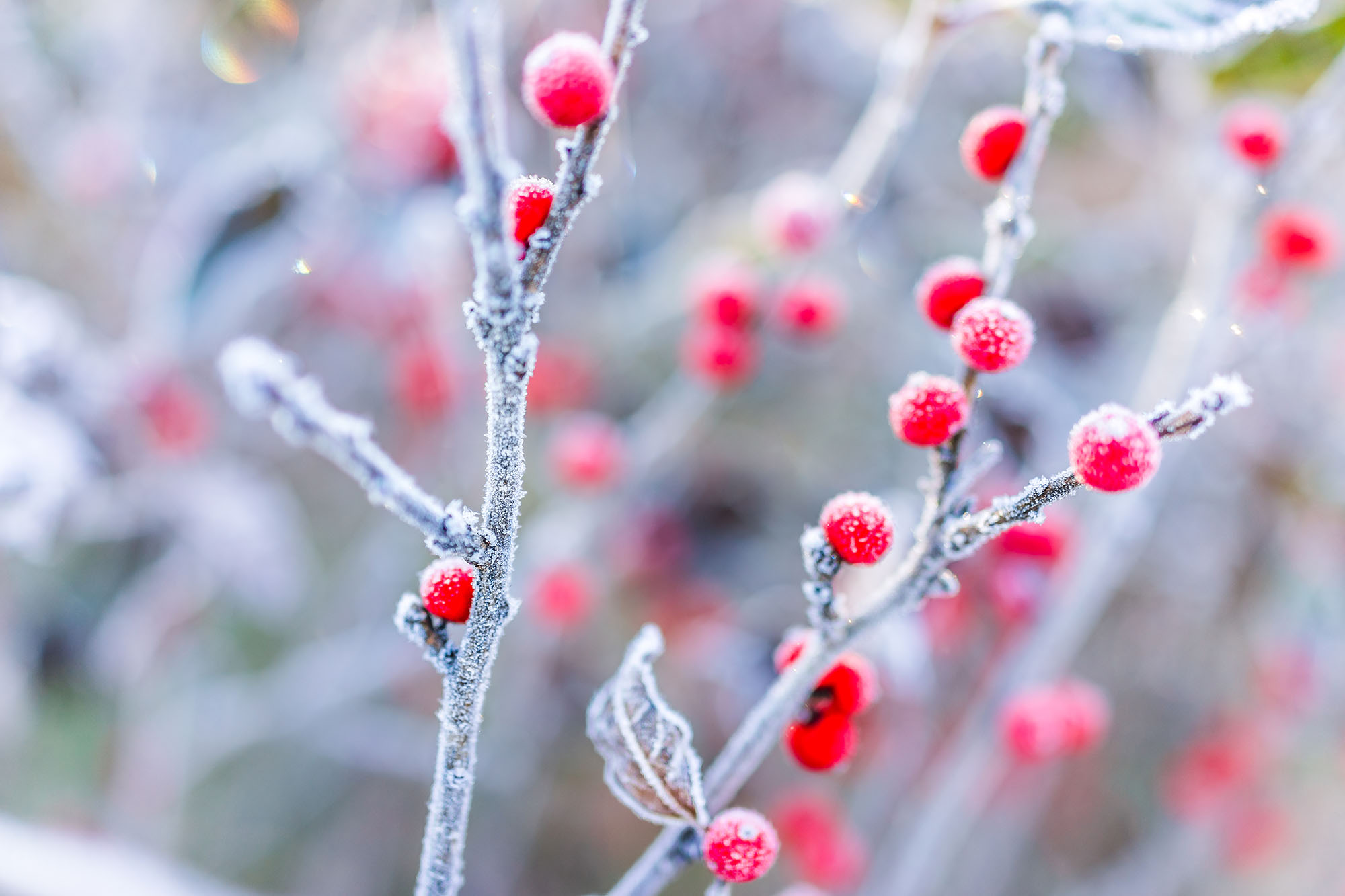
One sunny day in October, I glanced at my fourteen-year-old honeysuckle and noticed that its blossoms, once brimming with nectar, were deflated, about to drop to the garden floor. Sadly, I realized that the hummingbirds and summer had flown away, too.
As I took a closer look, though, I saw beautiful small berries forming on each branch. Red, round, and cheery, I learned they were right on time to feed the native birds who don’t fly south in the winter. I felt this honeysuckle’s friendship, for it was not leaving me as I had thought. Though relinquishing its summer splendor, it was still preparing to give. Then, on a recent walk in Greenbury Point, I came across an incredible plant studded with sparkling blue, turquoise, violet, white, and purple berries the size of robins’ eggs. I learned it was an invasive though ornamental weed called “Porcelain Berry.” Suddenly, I understood the singular beauty and intensity of the berry, the wonder of each variation, often hidden from view. To find them, you may need to peer intensely into thickets or explore the woods, but as they twinkle amid thorns or hang in clusters from bare branches, their clear forms engraved against the sky, they are the true lights of the winter landscape.
Following are a few recommendations for plants with especially bright and merry berries. Plant a few and behold the true gifts of winter. In the chaos of the holidays, they remind us to pause and take notice of nature’s great and quiet force and how it provides perfectly—not only for our spirits but also for more than 50 different species of wildlife that shelter in evergreen boughs and feed on super fruits such as Sea Buckthorn, Beautyberry, and Chokeberry. You may even wish for snow, which will surely release the berry’s pure magic.
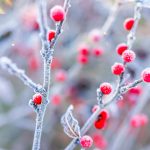 1. Winterberry Ilex verticillata
1. Winterberry Ilex verticillataA holly that loses its leaves in the fall, winterberry has brilliant red berries that give cheer to the winter landscape. Its leaves are not prickly (unlike the Sea Buckthorn!), so it is especially prized by florists and often used in flower arrangements, wreaths, and garlands.
Origin: Native to the Eastern United States
Grows: Hardy from -40 to 30 degrees Fahrenheit, grows well in Maryland’s Zone 7b
Water: Moist to wet soil
Light: Full sun to partial shade
Mature size: 3 to 12 feet tall and wide
Attracts: Attracts and feeds a wide variety of birds throughout the winter, including cedar waxwings, scrub jays, robins, ducks, and wild turkeys.
Fun fact: Native Americans brewed the bark of the winterberry to reduce fever, which may be how it received its common nickname, “fever bush.”
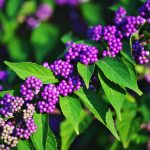 2. Beautyberry Callicarpa bodinieri var. giraldii
2. Beautyberry Callicarpa bodinieri var. giraldiiBeautyberry is well-named, with spectacular, vivid violet berries appearing in autumn. Happy in sun or partial shade, you’ll need to plant more than one to ensure pollination and, therefore, fruiting.
Origin: Native to America and the Southeastern United States
Grows: Zones 7 to 11
Water: Well-drained soil, drought tolerant when established
Light: Light shade
Mature Size: 3 to 8 feet
Attracts: Due to its high water content, beautyberry attracts more than 40 species of birds, as well as foxes, opossums, raccoons, armadillos, and squirrels.
Fun fact: In the early 20th century, farmers would crush beautyberries and place them under their horse’s harness to repel mosquitoes.
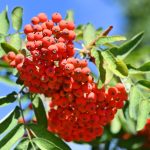 3. Chokeberry Aronia arbutifolia
3. Chokeberry Aronia arbutifoliaNative to the U.S. and Canada, this shrub has great fall foliage and fruit that turns bright red in the winter. Aronia is self-fertile and, unlike most hollies, will produce highly edible and nutritious berries on a single plant.
Origin: Native to Eastern North America
Grows: Hardy from -30 to 30 degrees Fahrenheit (Zones 4 to 9)
Water: Needs well-drained soil
Light: Full sun to partial shade
Mature size: 6 to 8 feet tall and 3 to 4 feet wide
Attracts: Grouse, cedar waxwings, thrushes, northern flickers and thrashers
Fun fact: Despite its name, chokeberry has superior edible and medicinal qualities, including higher antioxidant levels than blueberries, pomegranate, açai, goji, or mangosteen.
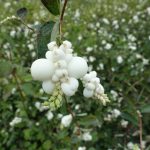 4. Snowberry Symphoricarpos albus
4. Snowberry Symphoricarpos albusSnowberry is a hidden gem, both beautiful and nutritious for wildlife and pollinators. A member of the honeysuckle family, it is very easy to grow. To maintain, simply prune away some of the suckers every few years to keep it in check.
Origin: Native to North and Central America
Grows: Zones 2, 3, 4, 5, 7
Water: Dry, medium, moist
Light: Full sun, partial shade
Mature size: 3 to 6 feet tall
Attracts: Birds, pollinators, deer resistant
Fun fact: When fishing, Native American hunting tribes would create a small dam and release crushed berries into the water. The toxic berries would attract the fish, suffocate them, and bring them up to the surface.
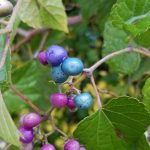 5. Porcelain Berry Ampelopsis glandulosa var. brevipedunculata
5. Porcelain Berry Ampelopsis glandulosa var. brevipedunculata Resembling miniature birds’ eggs, the dazzling berries start out white but gradually darken to shades of pink, lavender, turquoise, blue, and black as they age. The traits that make it a popular garden plant—such as its ground coverage, climbing habit, and pest resistance—also make it a robust invasive species. Prune hard and eliminate suckers.
Origin: Native to Asia
Grows: Zones 5 to 9
Water: Moist, well-drained soil, drought tolerant once established
Light: Full sun to part shade
Mature Size: If not controlled, can grow more than 20 feet tall
Attracts: Many birds and small mammals
Fun fact: In traditional Chinese medicine, stems and roots were used as anti-inflammatories, diuretics, and anti-hepatotoxins.
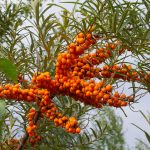 6. Sea Buckthorn Hippophae rhamnoides
6. Sea Buckthorn Hippophae rhamnoidesFound naturally growing along the coastline and on farmsteads, Sea Buckthorn is packed with vitamins C, A, and E. Deciduous silver-green narrow leaves have yellow flowers in spring, followed by orange berries through winter. Plant both male and female plants for pollination.
Origin: China, Russia, Mongolia, Northern Europe
Grows: Hardy down to Zone 3
Water: Do not overwater. Prefers subsoil moisture.
Light: Full sun to light shade
Mature size: 13 to 20 feet tall, spreading 11.5 feet
Attracts: Berries produced in autumn and winter are an important food source for migrant birds, such as fieldfares and redwings. At other times of the year, many species of birds feed upon the insects living in it.
Fun fact: Sea Buckthorn is a “super-fruit” high in antioxidants, vitamin C, carotenes, and amino acids. Berries can be crushed to make juice, jam, jelly, ice cream, mousse, and liqueur.
© Annapolis Home Magazine
Vol. 14, No. 6 2023